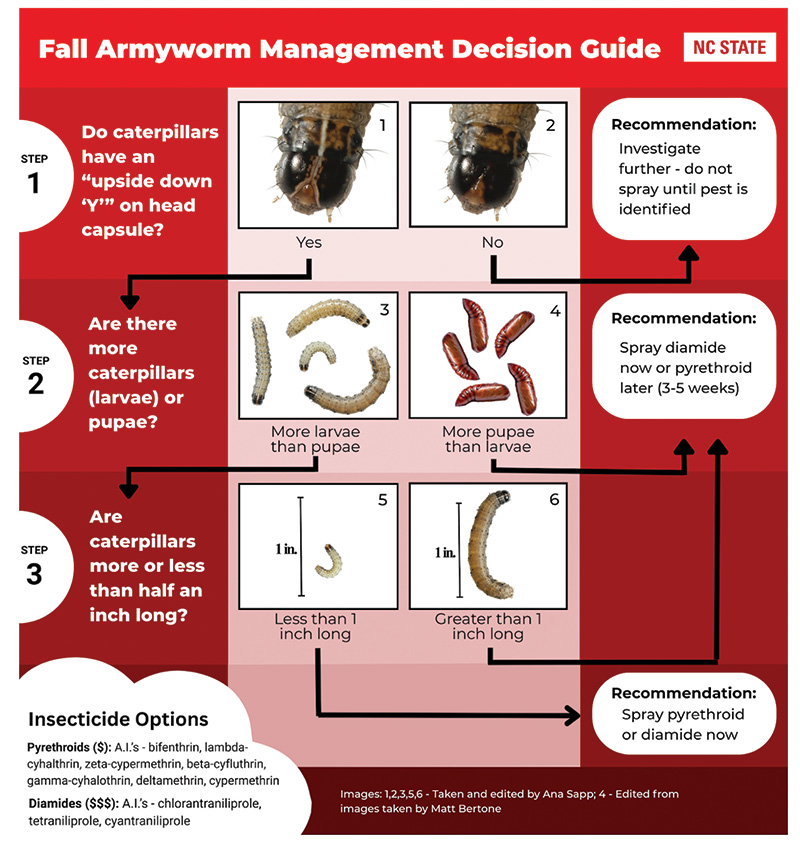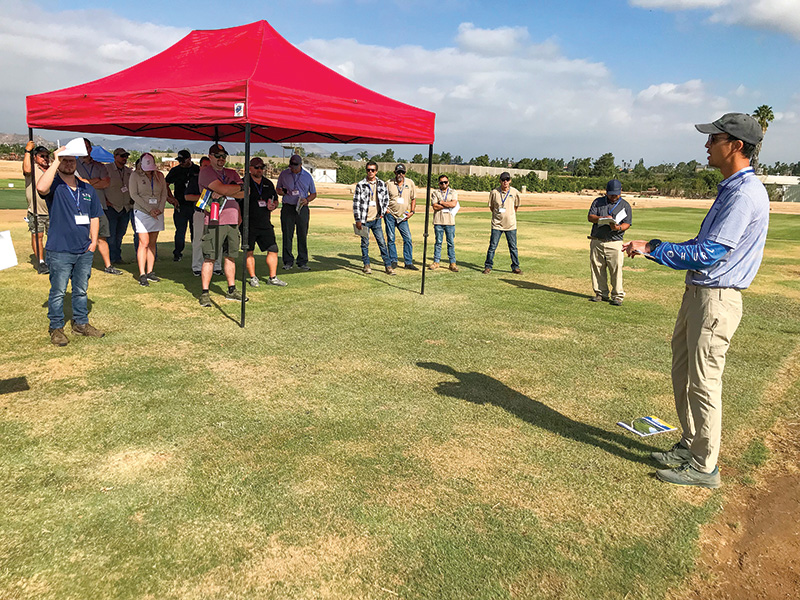
NCSU publishes updated fall armyworm management guide
North Carolina State University Extension has developed an easy-to-use management decision guide to help turfgrass managers determine the best insecticide approach, timing and options for control of fall armyworm. The guide (http://bit.ly/3VOw6ku) provides three steps toward management:
Step 1: Identify the pest. Examine the turf canopy to see if you can find fall armyworms crawling across the surface during the day. If not, you can apply a soapy water flush or cut a section of the turf to find what is causing the damage. If you find caterpillars, do they have an “upside-down ‘Y’” on the head capsule? If not, you need to investigate the source of damage further. Do not apply an insecticide until you have determined what is causing the damage. If the caterpillar has the “Y” marking, proceed to Step 2.
Step 2: Determine the life stage present. Once you have determined that fall armyworms are to blame, cut a small section of the turf and examine the top 2 inches of the soil profile. If you see more pupae (red-brown, inch-long capsules) than larvae (caterpillars), apply a diamide product (see “Insecticide Options” key for list of active ingredients) now or a pyrethroid product in three to five weeks. If you find more larvae (caterpillars) than pupae, proceed to Step 3.
Step 3: Caterpillar size. Get an approximate measurement of the length of a larva. If it is greater than 1 inch in length, apply a diamide product now or a pyrethroid product in three to five weeks. If it is less than 1 inch in length, you can spray a pyrethroid for a “quick-knockdown” that will not provide a long window of protection (one to two weeks maximum) or apply a diamide that will take a few days to work but will provide several weeks of protection. Remember: Use liquid formulations whenever possible, regardless of pesticide selection.
— Terri Billeisen (tlhoctor@ncsu.edu), Extension associate, Entomology & Plant Pathology, North Carolina State University Extension, Raleigh

Projects range from water conservation to new Coachella bermudagrass at UC-Riverside field day
Studies presented during the Sept. 11 Turfgrass & Landscape Research Field Day at the University of California-Riverside focused on warm-season grasses, with a highlight being the introduction and management of Coachella hybrid bermudagrass developed by the breeding program at UC-Riverside, led by James H. Baird, Ph.D.; Adam J. Lukaszewski, Ph.D.; and Christian S. Baldwin, Ph.D. “Coachella possesses a very dark, bluish-green genetic color, which sets it apart from most other newer and existing cultivars,” the breeders say. Coachella was selected for improved winter color retention or shortened winter dormancy. “It possesses a more vertical growth habit, which may lend itself to better ball lie, especially at taller heights of cut. Coachella also possesses better drought resistance than most cultivars, especially when no irrigation is applied.” The first commercial installation of Coachella was at The Farms Golf Club in Rancho Santa Fe, Calif., with 65 acres of sod installed on tees, fairways and rough.
Other projects presented during the first half of the field day focused on postemergence control of crabgrass in bermudagrass turf; preemergence control of kikuyugrass and annual bluegrass; and evaluation of products for water conservation on bermudagrass turf under deficit irrigation conditions. After a break for a trade show, researchers continued the field day with presentations on improvement of bermudagrass, kikuyugrass and zoysiagrass for winter color retention and drought tolerance; updating crop coefficients and plant factors for warm-season turfgrasses and 2025 NTEP bermudagrass test; and postemergence control of weeds in bermudagrass turf. Objectives, materials, methods and results for each project are contained in the 2025 Research Field Day booklet, which is expected to be available online soon. Check the UC-Riverside Turfgrass Science website for those details.
Darrell J. Pehr (dpehr@gcsaa.org) is GCM’s science editor.